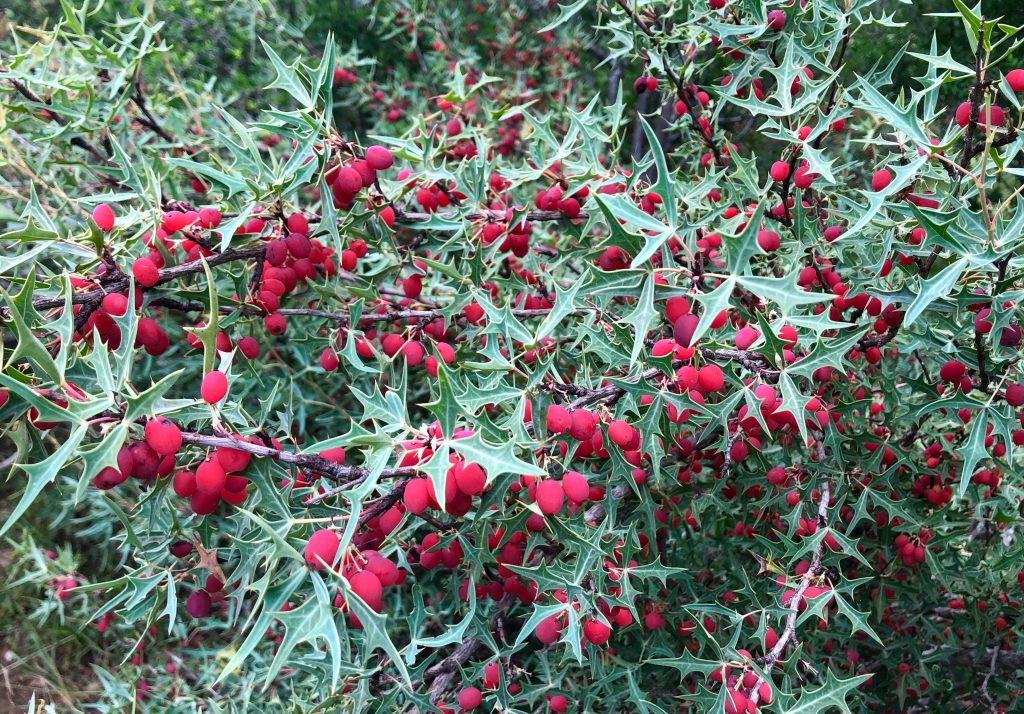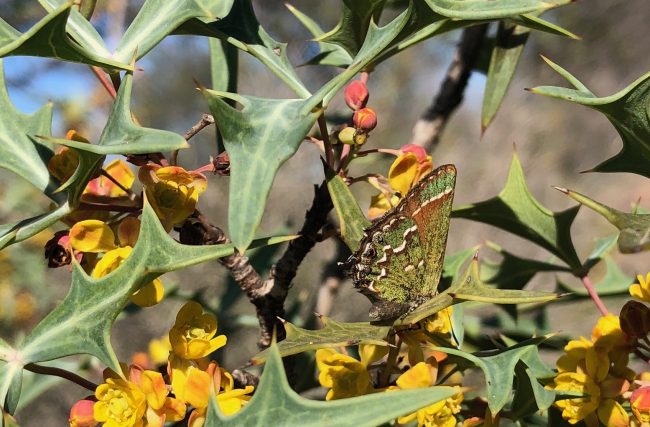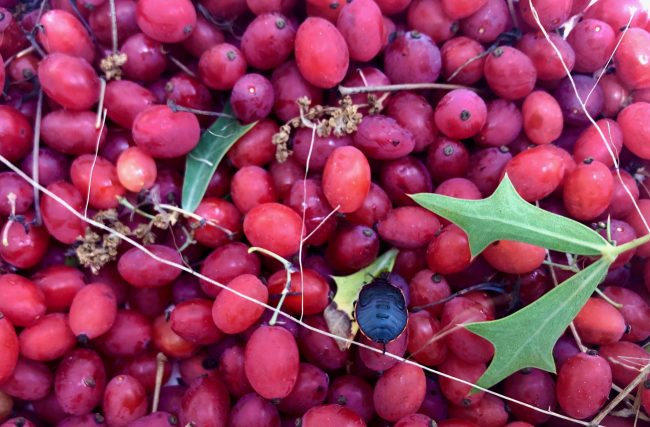Fans of the evergreen bush known as agarita enjoyed a spectacular season this year, but hot temperatures are bringing agarita season, and the availability of its tart red berries, to an end.
The evergreen bush, Mahonia trifoliata, makes itself known in early spring with redolent yellow flower clusters that draw bees and butterflies. Songbirds eat its fruits, quail and small mammals use the thorny shrub for cover. And people like Mike Casey of San Antonio inspire “agarita fever,” when the robust holly-like shrubs loaded with bright red berries make for a fun harvest outing followed by ritual jelly making.
Casey has been harvesting agarita berries from the hedge of his bungalow for more than 20 years. He relishes the fruits, sometimes called wild currents, tucked into the prickly shrub.
“I just get in a Zen mood like I’m counting beads,” said Casey, who collects the sweet-and-sour fruits barehanded. “The leaves themselves are firm and pointed like little needles. … It doesn’t reach the threshold of pain, but it is discomfort.”
The bush forms thickets in the Texas Hill Country, as in the picture below. Clusters of fragrant, yellow flowers appear in February and batches of the red berries follow in April and continue ripening into June.

Agarita: food for people, food for pollinators. Photo by Monika Maeckle
Agarita berries are the fruit of the most common species of barberry found in Texas. The stickery bush is among the first to bloom in the spring. Its fragrant yellow flowers serve as one of the earliest available nectar sources for bees and butterflies.
The plant’s thorny, five-pronged leaves also rank it high on the list of our state’s most ornery shrubs, so gathering its fruits calls for determination and a certain level of pain tolerance.
Agarita’s defensive prowess and multiple uses are undeniable. Foragers use agarita berries in tarts, pancakes, and cobblers or convert them into jelly, syrup, and juice.

Agarita tart. #yum Photo by Monika Maeckle
Wildlife also consume the berries, which are loaded with pectin, carbohydrates, Vitamin C, and antioxidants, said Patty Leslie Pasztor, a San Antonio botanical consultant and co-author of Texas Trees: A Friendly Guide.
Agarita seems to be a favorite of many beetles and bugs, as well as preferred fodder for birds, raccoons, opossums, and other wildlife. Deer don’t touch it, probably because they can’t get to the fruit without being stabbed. Texas state botanist Chris Best quantified agarita berry fans as “every frugivorous critter that can get its mandibles on them.”
Some speculate the plant’s name hails from the Spanish word agria, which means sour. But Kelly Lyons, a biologist at Trinity University and native plant expert, believes agarita comes from agarrar, to grab, in Spanish.
Pasztor lauds agarita’s potential as a barrier plant. She recalled how proprietors of the Tobin Estate in San Antonio used it as a protective perimeter hedge. “They would prune it periodically, but imagine: a blooming and fruiting hedge that’s pretty impenetrable,” she said. “Some people plant it by their teenager’s windows.”
The Foraging Texas website cites the many uses of agarita. Its plentiful seeds can be roasted and ground for a caffeine-free coffee substitute. Other ethnobotanical sources praise agarita’s myriad uses: leaves can be chewed to prevent nausea, wood can be boiled to make dyes, and roots utilized to fight fungi and bacterial infections.
“One gentleman told me that his mama used to grind up agarita root and sprinkle it in his shoes for athlete’s foot,” Pasztor said.
Unfortunately, agarita is not widely available in nurseries. If you find yourself smitten with this plant, you’ll have to check out native plant sales, shop at specialty nurseries, grow it from seed or transplant from the wild.

One of the first blooms in spring, Agarita draws bees, butterflies and other insects. Here, a Juniper Hairstreak. Photo taken on Feb. 27, 2019 by Monika Maeckle
Our friends at the Ladybird Johnson Wildflower Center suggest if you move agarita from one location to another, to first put the plant in a pot for up to a year to stabilize it.
“Moving them is a sketchy endeavor regardless,” said Andrea DeLong-Amaya, the Austin-based center’s Director of Horticulture. “The best chance you’d have for transplanting is to dig up small plants (the smaller the better) and get as much of the root as possible.”
DeLong-Amaya suggested “mudding them in,” which is to dig a hole, place the plant in it, then simultaneously fill the hole with soil and water.
“This creates a slurry which settles around the roots better than just re-filling the soil into the hole and watering afterward,” she said, adding that “your best chance is to grow them from seed.”
According to How to Grow Native Plants of Texas and the Southwest, growing agarita from seed takes three years to produce a five-gallon plant. Fruit will follow, but the timing of that is unpredictable, and depends largely on light, temperature and water. Well-drained soil is a must. Seeds are available online, but be sure to get Mahonia trifoliata.
Some would argue that the toughest part about loving agarita is getting the berries off the bush.
The classic harvesting approach is to lay a sheet on the ground and beat the bush with a broom. A more efficient method: Place an umbrella under a branch flush with berries and comb the spindly ream, from the inside of the bush out, since the prickly leaves face outward. Wear protective, elbow-length gloves.
Inevitably, twigs, agarita leaves, dirt, organic matter, and numerous insects will accompany your berry harvest. Once you have your bowl of berries, pick out the detritus. Piling a cup or so of berries on a small mesh screen – such as a spatter screen – while tilting and shaking slightly also can serve to separate the fruit from unwanted debris. Casey dumps the berries on a sheet in front of a floor fan.
“I turn it up to hurricane speed, and that just blows out the leaves and detritus,” he said.
Mike Casey’s Famous Agarita Jelly Recipe adapted from Irma S. Rombauer’s The Joy of Cooking,
- Pick berries
- Winnow the leaves and any extraneous particles by putting an old fitted sheet on the floor. Use a fan at high speed to blow the chaff from the berries. If you can slowly pour the berries onto the sheet in front of the fan a couple of feet away, it blows away the leaves and particles. This is a job for two.
- Rinse berries.
- Put 2 quarts of berries in a pot with enough water to reach the top layer of berries.
- Bring to a boil and reduce heat to a simmer and cook until the berries are splitting and losing their color.
- Strain through a jelly bag. Fine mesh bags are available from a paint store.
- Measure 6 cups of juice and heat to a boil, reduce heat, add 4 cups of sugar and bring the temperature to 8 degrees above boiling point. My thermometer shows boiling at 214 at King William’s elevation. This is the jelling point.
- Pour into sterilized jelly jars.
Got agarita stories or recipes to share? Leave them in the comments.
TOP PHOTO: Agarita berries. The plant is beloved by creatures of all sorts, including this beetle. Photo by Monika Maeckle
Related posts:
- 300for300 pollinator initiative: 500 by 2020?
- Popularity of pollinator gardens growing in areas prone to drought
- Planting a butterfly garden? Here’s tips on how to do it
- Mostly native butterfly garden outperforms lawn every time
- A year in the life of an urban butterfly garden
- Downtown River walk plot converts to pollinator garden, creature haven
- Converting your Lawn to a Butterfly Garden
- San Antonio becomes first National Wildlife Federation Monarch Champion city
- Tropical Milkweed: To Plant it or Not is No Simple Question
- How to raise Eastern Swallowtails
- How to raise Monarch butterflies at home
Like what you’re reading? Don’t miss a single post from the Texas Butterfly Ranch. Sign up for email delivery at the very bottom of this page, like us on Facebook, or follow us on Twitter, @monikam.


Great post! I have yet to harvest agarita berries, but intend to turn that around
next season!
oh… thanks for such useful info. great post
Where can I buy them. I’m in east texas.
Remember enjoying the flowers and harvesting the fruit when out doing tree research in the seventies. Was hoping to find some to grow up here in Far Rockaway, which is by the water and a zone level warmer than the rest of New York City. Wonder if it would do well in a huge pot which could be dragged inside if we have the once in five years, colder than usual winter.
A little late in commenting as I just found this. I have wonderful memories of harvesting agarita berries and young tender nopalitos at Easter time with my mother, grandmother and aunts and uncles at our ranch in San Diego, Texas.
Some years the harvest was prolific. Harvesting was laborious. The sheets would come out and the whole family got involved. Then jelly was made. Yum.
I haven’t been to the ranch in almost two decades but will be visiting in two weeks for a memorial service. I’d love to find an agarita to try to transplant. Wish me luck.
Post Script Query: Anyone having any luck finding Mimosa Borealis? Brother has seen Mimosa Texana but not the Borealis. – Thanks Joyce
I found a baby agarita in my front garden and am going to do my best to do right by it.
I had a wild one at my last house and would love to have one at my new one. Wish me luck!
Just transplanted an agarita after two years of longing for one. I cut it out directly from the plantar and managed to get all of it’s soil plus plant into the ground. I created the mud slurry after that, just as the article suggested. Fingers crossed that she takes and likes her new home. Thanks!
Excellent story! I have one right out my window, loaded with berries. Can’t wait to make jelly this year!
Also, “…doesn’t reach the threshold of pain…”?! Mike Casey is either super human or has no nerve endings.
Is Agarita self pollinating or does it require a male and female plant? Thanks
The flower is considered to be perfect, that is, each individual flower contains male and female reproductive organs. Bees love it in early spring when little else is blooming. —MM
Grew up in hill country outside of Leander. Remember raiding the bushes at the bus stop as a kid. Mom made jellies of them. I grew up calling them ‘Algeritas’ so I’m happy to find them under this name.
I wonder if they will grow in the DFW area as that’s where I’m at now.
I had a bumper crop on the agaritas bushes that are in my yard in 2023. This year, I have nothing on my bushes, yet, I’m finding bushes that are loaded in the surrounding area. Any idea why this happens? I’ve noticed this on a couple of occasions so I’m not sure if I can blame the weather.